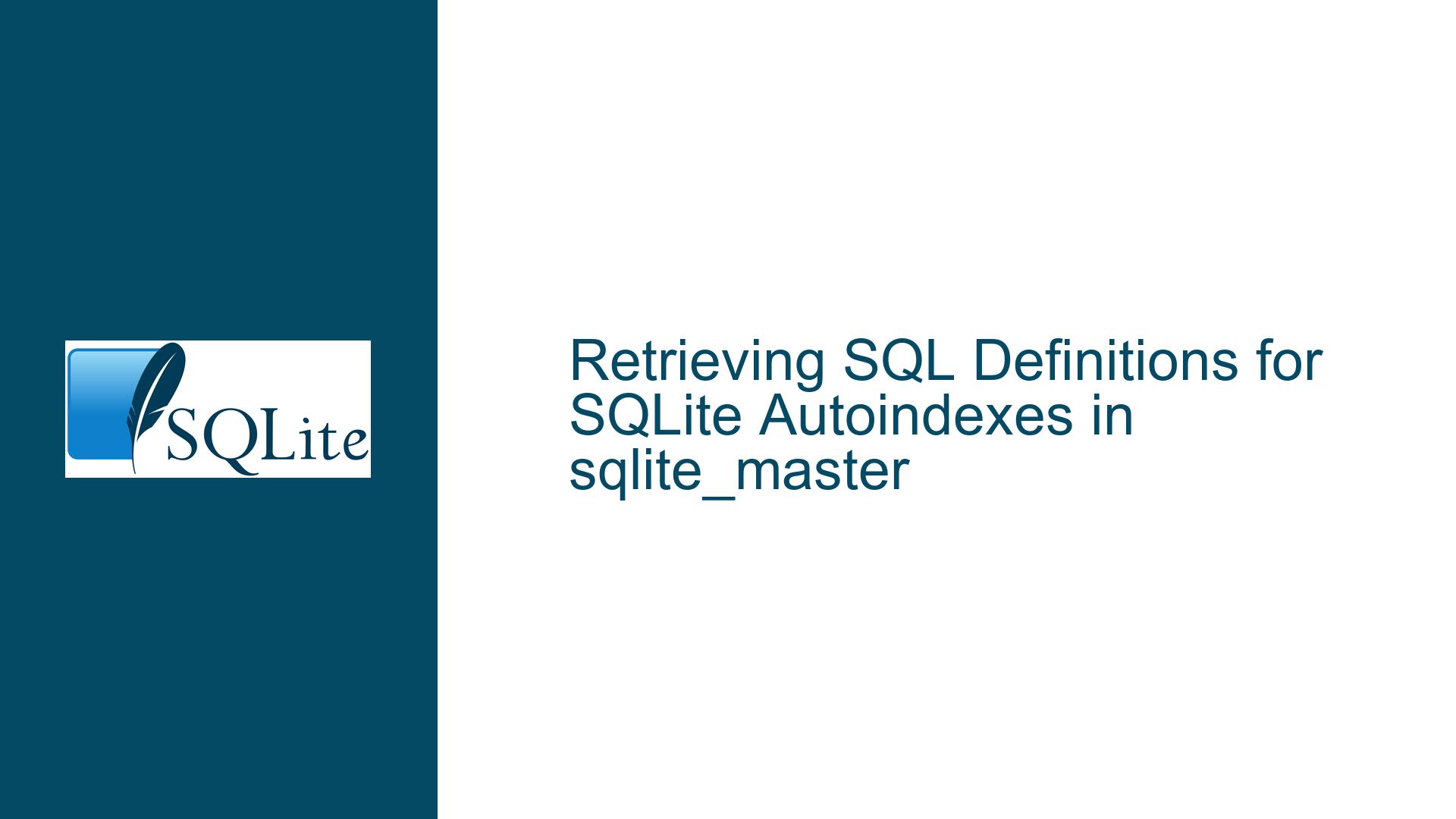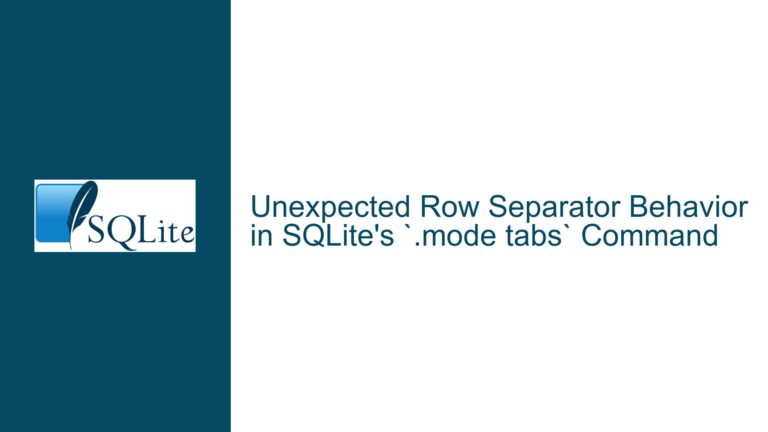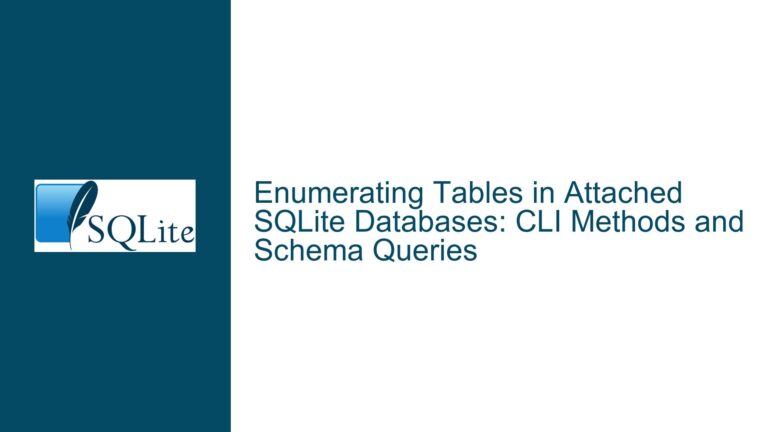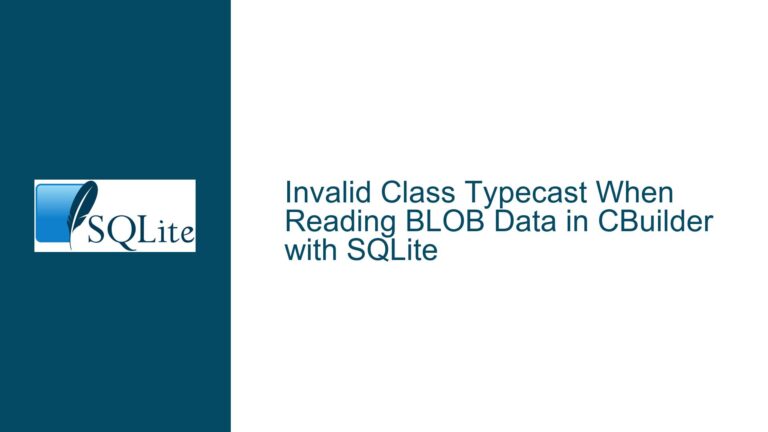Retrieving SQL Definitions for SQLite Autoindexes in sqlite_master
Understanding Autoindex Metadata Visibility in sqlite_master
Autoindexes in SQLite are automatically generated indexes created to enforce uniqueness constraints on tables. When a table is defined with a PRIMARY KEY or UNIQUE constraint that cannot be mapped to an existing explicit index, SQLite generates an implicit index known as an autoindex. These autoindexes are critical for maintaining data integrity but pose a unique challenge: their definitions do not appear in the sqlite_master system table as user-created indexes do.
The sqlite_master table stores the schema for all database objects, including tables, views, triggers, and explicit indexes. Each entry contains a sql column with the exact SQL statement used to create the object. However, autoindexes are exceptions. Their entries in sqlite_master lack the sql column value because they are generated implicitly by SQLite’s query planner rather than through explicit CREATE INDEX statements. This design choice reflects the fact that autoindexes are derived entirely from table constraints and do not exist independently.
This absence of SQL definitions complicates tasks such as schema documentation, migration scripting, and debugging. Users inspecting sqlite_master will see entries for autoindexes with type='index', name values prefixed with sqlite_autoindex_, and a tbl_name pointing to the source table. However, the missing sql column necessitates alternative methods to reconstruct their definitions. The core challenge lies in programmatically generating accurate CREATE INDEX statements for these autoindexes using metadata from SQLite’s internal pragmas and system tables.
Limitations of PRAGMA Functions in Reconstructing Autoindex Definitions
To address the absence of autoindex SQL in sqlite_master, SQLite provides pragma functions such as pragma_index_list and pragma_index_info. These functions return metadata about indexes, including their uniqueness, columns, and collations. However, using these pragmas effectively requires understanding their limitations and integration with other system tables.
Pragma Input Requirements:
Thepragma_index_listfunction requires a table name as input. A query likeSELECT * FROM pragma_index_list();will fail because it lacks the necessary table name argument. Instead, it must be called for each table individually or joined dynamically withsqlite_masterentries. This complicates batch operations where a user wants to retrieve all autoindexes across the entire database.Column Attribute Inheritance:
Autoindexes inherit collation and nullability rules from the columns they index. For example, if a columnidis defined asUNIQUE NOT NULL COLLATE NOCASE, the autoindex will enforce uniqueness based on theNOCASEcollation. However, these attributes are not stored in the autoindex metadata itself. Thepragma_index_inforeturns column names but not collations or nullability constraints. Reconstructing the full index definition requires cross-referencing the table’s original schema.Identifier Formatting:
Autoindex names follow the patternsqlite_autoindex_<table>_<N>, where<N>is a sequential number. When generatingCREATE INDEXstatements, these names must be escaped if they contain special characters. For example, a table namedOrder.Detailswould produce an autoindex namedsqlite_autoindex_Order.Details_1, which requires quoting in SQL statements:CREATE INDEX "sqlite_autoindex_Order.Details_1" ....Schema-Origin Consistency:
Autoindexes are always tied to the schema of their parent table. If a table is altered (e.g., columns are renamed or dropped), the associated autoindexes are automatically updated or removed. This dependency means that any reconstructedCREATE INDEXstatement must align with the table’s current schema to remain valid.
Generating CREATE INDEX Statements for Autoindexes via Pragma Joins
To reconstruct the SQL definition of an autoindex, combine metadata from sqlite_master with results from pragma_index_list and pragma_index_info. The following steps outline a robust method to generate accurate CREATE UNIQUE INDEX statements for all autoindexes in a database.
Step 1: Identify Autoindexes Using sqlite_master
Filter sqlite_master for index entries whose names start with sqlite_autoindex_. This isolates implicitly created indexes:
SELECT name, tbl_name
FROM sqlite_master
WHERE type = 'index'
AND name LIKE 'sqlite\_autoindex\_%' ESCAPE '\';
Step 2: Retrieve Index Metadata with pragma_index_list
For each table, use pragma_index_list to list its indexes. Join this with sqlite_master to dynamically process all tables:
SELECT m.name AS table_name, l.name AS index_name, l.origin
FROM sqlite_master m
CROSS JOIN pragma_index_list(m.name) l
WHERE m.type = 'table';
The origin column indicates whether an index was created automatically ('u' for uniqueness constraint) or manually ('c' for explicit CREATE INDEX).
Step 3: Extract Column Details with pragma_index_info
For each autoindex, query pragma_index_info to list its columns. Aggregate these columns into a comma-separated string:
SELECT group_concat(name, ', ') AS columns
FROM pragma_index_info('sqlite_autoindex_mytable_1');
Step 4: Assemble the CREATE INDEX Statement
Combine the above steps into a single query that generates the full SQL for autoindexes. Use a Common Table Expression (CTE) to improve readability:
WITH autoindex_data AS (
SELECT
m.tbl_name AS table_name,
l.name AS index_name,
(SELECT group_concat(name, ', ') FROM pragma_index_info(l.name)) AS columns
FROM sqlite_master m
CROSS JOIN pragma_index_list(m.name) l
WHERE m.type = 'table'
AND l.name LIKE 'sqlite\_autoindex\_%' ESCAPE '\'
)
SELECT
'CREATE UNIQUE INDEX ' || index_name || ' ON ' || table_name || '(' || columns || ');' AS sql
FROM autoindex_data;
Step 5: Merge with sqlite_master for Complete Schema Export
To produce a comprehensive schema dump that includes both explicit and autoindex definitions, left-join the generated autoindex SQL with sqlite_master:
WITH generated_autoindexes AS (
SELECT
l.name AS index_name,
'CREATE UNIQUE INDEX ' || l.name || ' ON ' || m.tbl_name || ' (' ||
(SELECT group_concat(name, ', ') FROM pragma_index_info(l.name)) || ');' AS sql
FROM sqlite_master m
CROSS JOIN pragma_index_list(m.name) l
WHERE m.type = 'table'
AND l.name LIKE 'sqlite\_autoindex\_%' ESCAPE '\'
)
SELECT
m.type,
m.name,
m.tbl_name,
m.rootpage,
COALESCE(m.sql, g.sql) AS sql
FROM sqlite_master m
LEFT JOIN generated_autoindexes g ON m.name = g.index_name;
Key Considerations:
- Collation and Nullability: Since autoindexes inherit these from the table schema, they do not need to be explicitly stated in the
CREATE INDEXcommand. The reconstructed SQL will match the effective behavior of the autoindex. - Identifier Quoting: Use
QUOTE()or manual escaping for table/index names with special characters:'CREATE UNIQUE INDEX ' || QUOTE(index_name) || ' ON ' || QUOTE(table_name) || ' ... ' - Schema Versions: The generated SQL reflects the current schema. If the table is altered, rerun the query to update the autoindex definitions.
By following these steps, users can achieve parity between explicit and autoindex representations in schema exports, enabling accurate backups, migrations, and documentation.






